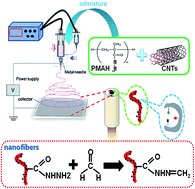An electrochemical impedimetric sensor based on biomimetic electrospun nanofibers for formaldehyde
Abstract
Herein, simple molecular recognition sites for formaldehyde were designed on electrospun polymer nanofibers. In order to improve the conductivity of the electrospun polymer nanofibers, carbon nanotubes were introduced into the resulting nanofibers. By employing these functionalized nanocomposite fibers to fabricate a biomimetic sensor platform, an obvious change caused by recognition between recognition sites and formaldehyde molecules was monitored through electrochemical impedance spectroscopy (EIS). The experimental conditions were optimized and then a quantitative method for formaldehyde sensing in low concentration was established. The relative results demonstrated that the sensor based on biomimetic recognition nanofibers displays an excellent recognition capacity toward formaldehyde. The linear response range of the sensor was between 1 × 10−6 mol L−1 and 1 × 10−2 mol L−1, with the detection limit of 8 × 10−7 mol L−1. The presented research provided a fast, feasible and sensitive method for formaldehyde with good anti-interference capabilities and good stability, which could meet the practical requirement for formaldehyde assay.


 Please wait while we load your content...
Please wait while we load your content...